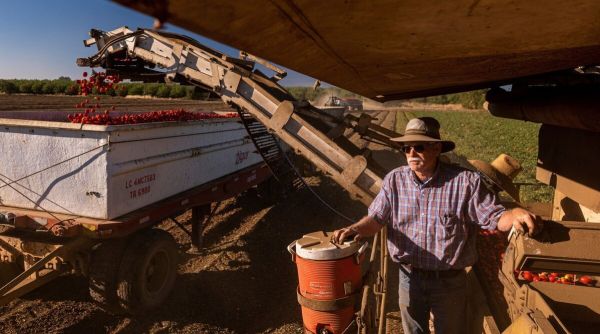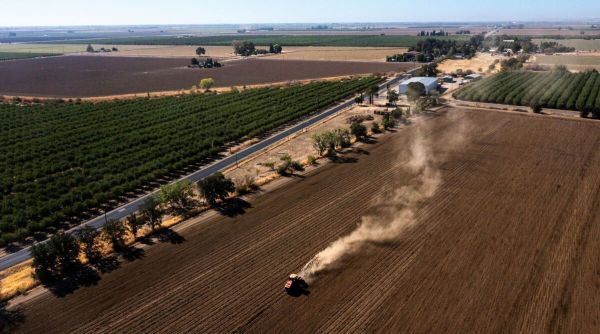
Squeeze the tomatoes.
California leads the world in the production of processing tomatoes, the variety that is preserved and used in commercial kitchens to make some of the most popular foods. The problem is that the worst drought in 1,200 years is forcing farmers to grapple with a water crisis that is undermining the harvest, threatening to drive up the price of spaghetti sauce even more.
“We desperately need rain,” Mike Montna, head of the California Tomato Growers Association, said in an interview. “We’re reaching a point where we don’t have enough inventory left to keep up with market demand.”
The lack of water is reducing production in a region responsible for a quarter of the world’s production, which is having an impact on the prices of tomato-based products. Gains in ketchup and ketchup are outpacing rising U.S. food inflation, which is at a 43-year high, blamed on drought and rising farm inputs. With California’s climate change forecasts calling for warmer and drier conditions, the outlook for farmers is uncertain.
“It’s very difficult to grow a tomato right now,” Montna said. “On the one hand, you have the drought that affects costs because you don’t have enough water to grow all your acres, and then you have the agricultural inflation part with fuel and fertilizer costs that are skyrocketing.”
Bruce Rominger, a fifth-generation farmer, reduced rice planting by 90 percent to make room for tomatoes on his farm in Winters, California. (Source: Bloomberg)
California restrictions limiting groundwater use and rising labor, fuel and fertilizer costs have caused headaches for growers like Woolf Farming. It costs a Fresno County grower and processor about $4,800 an acre to grow and harvest a tomato crop these days compared to $2,800 a decade ago, according to Rick Blankenship, vice president of farm operations. Most of the increases have occurred in the last two years. This season’s bounty costs more and offers less.
“Yields are very tight this year,” Blankenship said in an interview. “Along with the drought, we’ve had high temperatures and that in itself creates a problem where the tomatoes are so hot that they’re not the right size, so you’ve got a lot of tomatoes on the plant, but they’re smaller.”
Getting a higher value for field crops is usually an incentive for farmers, but this season’s negotiated rate of $105 a tonne for tomatoes, an all-time high, may not be enough to overcome the challenges of the industry
“You might think it was a home run for producers, but in reality the input costs have gone up so much that the potential profit was swallowed up,” Blankenship said.
Water issues have prompted a crop shift as growers try to gauge which commodity will bring the biggest profits. Bruce Rominger, a fifth-generation farmer, reduced rice planting by 90% to make room for tomatoes. He expects to make a profit from the 800 hectares of tomatoes he started harvesting in July, although it’s a gamble.
“It’s a high-risk crop and our yields so far are below average,” Rominger said, noting that excessive heat, lack of water and mid-April frosts took their toll.
 A field of tomatoes in Winters, California, US, Friday, August 12, 2022. (Source: Bloomberg)
A field of tomatoes in Winters, California, US, Friday, August 12, 2022. (Source: Bloomberg)
And it only gets worse. Higher temperatures will reduce the supply of processing tomatoes in key regions in the coming decades, with the US, Italy and China expected to decline by 6% by 2050, according to an academic study published in Nature Food. Increased heat and water constraints may make it especially difficult for California and Italy to maintain current production levels, according to the June report.
California’s crop has been below the recent production peak of 14.4 million tons in 2015 for the past six years, and 2022 is shaping up to continue the trend, according to data from the US Department of Agriculture. The industry expects this year’s harvest to fall short of the USDA estimate of 11.7 million tons.
“Despite low supply and a substantial price increase, contracted production is down significantly compared to early 2022,” the USDA said in its May report on California’s processing tomato crop. noting that the availability of water is the main problem facing producers.
“There just aren’t enough acres of processing tomatoes being planted this year to ensure everyone gets their full supply,” said R. Greg Pruett, sales and energy manager for Ingomar Packing Co., one of the largest tomato processors in the world. “Water is too expensive or simply not available at any price.”
These pressures are being reflected in Ingomar’s processed products. Tomato paste prices for customers of the company, which sells to some of the biggest food brands in the US, have risen as much as 80% compared to a year ago. However, with inventories falling to very low levels, supply is not available to everyone.
“If you’re looking for a significant amount of tomato paste and you haven’t contracted it yet, you’re not going to get it, no matter what the price,” Pruett said in a phone interview. “It’s just not there.”
Because tomato-based products are difficult to substitute, demand is not particularly sensitive to price changes. Still, it’s an added cost for consumers. The price of ketchup in the four weeks ended July 10 is up 17% from a year ago, while ketchup is up 23%, according to market research firm IRI.
“Obviously, there’s a point where that relationship will break down if frozen pizzas and pasta sauce and other staples are priced to the point where the average consumer wants to decide to do something else,” Pruett said.

